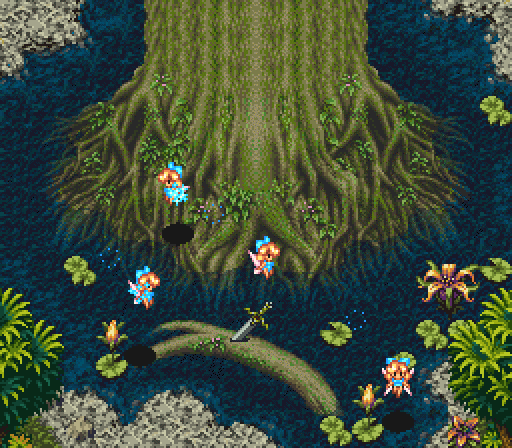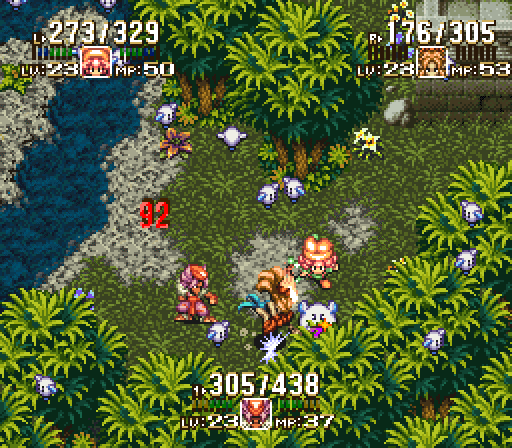|
|

|
PLATFORM
|
SNES
|
BATTLE SYSTEM
|

|
INTERACTION
|

|
ORIGINALITY
|

|
STORY
|

|
MUSIC & SOUND
|

|
VISUALS
|

|
CHALLENGE
|
Hard
|
COMPLETION TIME
|
20-40 Hours
|
|
OVERALL

|
+ Good graphics.
+ One of few action RPGs with a class system...
- ...which requires a guide to understand.
- Battles and menus feel clunky.
- Story is somewhat superficial.
- Soundtrack is somewhat forgettable.
|
Click here for scoring definitions
|
|
|
In ancient times, the Mana Goddess defeated the eight God-Beasts with the Sword of Mana, trapping them in eight stones across the world. However, some have sought the power of the stones, heralding the end of peace and causing conflict between nations. Squaresoft's Seiken Densetsu 3, the sequel to Secret of Mana, takes place as the power of Mana is fading, and said conflicts are reaching their apex. The third main installment of the company's Seiken (or Mana) franchise for over a decade has not seen release beyond Japan, and since the sequel is essentially devoid of the elements that made its predecessor fun, it is understandable why Seiken 3 remained in the Land of the Rising Sun.
When starting a new game, the player can select a main protagonist and two allies that will join him/her during the game, with these choices being permanent, yet having some sort of effect on various events throughout the game, with different endings as well, theoretically adding some degree of replayability. However, if one subtracts all that was fun about Secret of Mana, what largely remains is its sequel's battle system. Gone, for one, are different types of weapon and magic levels to build, replaced instead by fixed weapon types for each character, with new weapons available to buy at stores alongside traditional armor.
Battles actually begin in dungeons and fields outside towns when the player's characters draw near the enemy, in which case they take out their weapons and slow to a snail's pace. After a character swings his or her weapon, that character must wait for about a second to "recharge" before being able to attack normally again. As characters land hits, their special gauges fill, allowing them to perform a more powerful attack when maxed out. Interestingly, if said special attacks miss, the attack gauge doesn't empty, only doing so when they do indeed hit.
 The sword in the...root
The sword in the...root
|
|
Defeated enemies yield experience and money, and when a battle on a screen actually "ends," a treasure chest may drop, with a special roulette sometimes appearing along with the chest's item, with several potential traps (or none at all) to stop on, such as damage or a mimic chest to fight. When level-ups do occur (with levels rising very slowly, unfortunately), the player can increase one of a character's many stats by one. Though each character has MP, magic doesn't actually play into the battle system until the time comes when characters can change their classes.
When a character reaches Level 18, he/she can change his/her class at one of the eight Mana Stones to "Light" or "Dark," with each form having different magic to learn sometimes after leveling, increased stats, and additional special attack levels that can more easily clear rooms of enemies. Each character can change classes a second time at Level 38, with Light and Dark incarnations again available, accounting for four different final classes for each character, although doing so then requires special items the player might not even find without a guide. Since class changes are permanent, the player can't experiment in this area, so if they don't like the abilities of the classes to which their characters change, too bad.
All in all, the class system is a generally poor substitute for Secret of Mana's weapon and spell levels, even if the game becomes slightly more playable once all characters have changed classes. Still, battles feel somewhat clunky throughout the game, with Seiken 3 also dropping in some ultra-cheap foes late in the game that, coupled with no continue system, can make the third game torture to play at times. Longer-than-average boss fights come into play, as well, and ultimately, combat isn't nearly as enjoyable as it was in the game's predecessor.
Interaction, unfortunately, doesn't fare any better, worse, in fact. While the series' fabled ring menus return for consumable items in battle, not necessarily a bad thing, there are other things that more gravely plague the interface. For one, the game utilizes a nine-paneled menu screen for things such as viewing the party's stats and changing equipment, with said screen feeling very clunky and sluggish, and making character management something of a nightmare. There are also dozens of types of consumable items, only a few of which the player can actually bring into battle, with another clunky menu necessary to change battle items and items in storage.
 One of the Mana Stones, defying gravity
One of the Mana Stones, defying gravity
|
|
While said limits add to the balance of the battle system, they create a shopping problem outside of battle, where the player can only buy one item at a time, and if the player wishes to stock up on various kinds of items, the player must constantly choose to send bought items into storage, easily taking the fun out of shopping. Other non-combat aspects, such as dungeon design, could have been better, as well, given the convoluted nature of many dungeons and the often-terrible spacing of save points, which don't always come right before tough boss battles. Pretty much the only saving grace is that the game does a half-decent job late on telling players how to advance the main storyline, but still, interaction is easily the game's low point.
Seiken 3 continues the franchise's tradition of doing something drastically different with each installment, with combat feeling different (the third installment in fact being one of very, very few action RPGs with a class system), alongside the ability to choose three of six characters. Superficial similarities to its predecessors, such as the power of Mana, the elementals, many enemies, and so forth, recur, but the third installment is still reasonably distinct.
All the characters of Seiken 3's plot have some kind of story behind them, although as with its predecessor, the general plot still feels somewhat superficial, with other parts of it, such as the conflicts between the world's various nations and many of the villains, largely lacking depth, with the pacing at certain parts being a bit poor as well. Ultimately, even if the story was "good for its time," it's still lacking in areas, yet has some things going for it.
 Rabite hunting
Rabite hunting
|
|
The soundtrack is also somewhat lacking, mostly being a step down from that in Secret of Mana, with most tracks being hit-or-miss. There are some decent tracks, such as occasional remixes of the theme from Secret of Mana, although there are plenty of unmemorable ones, as well, such as over-ambient dungeon tracks. The sound effects are adequate, but the music could have easily been better, with composer Hiroki Kikuta seeming to have lost a bit of his touch in the sequel.
Seiken 3's visuals are easily its high point, its hues being somewhat darker than those in its predecessor, with decent scenery, spell and ability effects, character sprites, and monster designs, even if many of them are palette swaps. All in all, a nice-looking game.
Finally, the third installment is longer than its predecessor, taking somewhere from twenty to forty hours to finish, depending partly upon the player's luck. Overall, Seiken Densetsu 3 is a mostly unremarkable sequel, with clunky combat and menus alongside a superficial plot and forgettable soundtrack, its visuals being its sole saving grace. The third game, moreover, is an unfortunate turning point in the Mana franchise, one where each subsequent installment must absolutely do something drastically different, with the series consequently falling flat on its face each time. Only if a port or remake addressed its problems would it deserve to see the light of day outside the Land of the Rising Sun.
Review Archives
|









